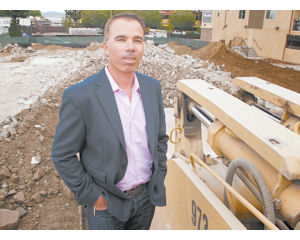Ask any homebuilder today — and despite a slowly improving economy— they’ll likely grumble about their access to financing, blaming the situation for why their single-family communities aren’t getting off the ground. Shawn Evenhaim, chief executive of California Home Builders, doesn’t have such problems. The Canoga Park developer finances all of its projects on its own dime — with some help from credit lines. And the developer is busy. The company has 10 multifamily and single-family home projects under construction or about to break ground throughout the San Fernando Valley. The new homes are located in Pacoima, Sylmar, Tarzana, Northridge, Sherman Oaks, Toluca Lake, Valley Village and Canoga Park. “When you use your own resources, you have the luxury to build that project,” Evenhaim said. “I don’t have to ask anybody.” So far, the developer’s risk is paying off. The Village at Pierce — a 57 single-family home community in Pacoima — is selling fast. The project held its grand opening in late February. The developer already has sold out the first phase of the project, which was a dozen homes. Another 17 are in escrow in later phases, Evenhaim said. Construction also is underway on the third and fourth phases. The two-story, Spanish Villas have four bedrooms, 2.5 baths and come equipped with a solar panel system. Prices range from $275,900 to $309,900. A 48-unit Valley Village multifamily project is scheduled to come online in August. And the company recently broke ground on a community in Sylmar that will have 18 single-family homes and is scheduled to open in six months, Evenhaim said. “This probably will be our biggest year,” he said. He declined to disclose revenues. California Home Builders also is demolishing a shuttered car dealership on Roscoe Boulevard in Canoga Park and will build a new 81-unit multifamily project. Another 81-unit project — built by the company and recently sold — rests adjacent to the demolition zone. Last year, financing for multifamily construction became easier, but the lending market still hasn’t fully recovered compared to the levels seen in the boom years, said multifamily specialist Warren Berzack of the Berzack Group with Lee & Associates-LA North/Ventura Inc. Berzack recently represented Evenhaim in a purchase of vacant land in Canoga Park. The lending environment has prompted more developers to pick up land with cash and use their own capital or funds from private investors to start construction on apartment projects. “The banks want to know you have more skin in the game,” Berzack said. But while multifamily financing has eased some, single-family homebuilders are largely stuck in neutral. California Home Builders has kept going by financing its own projects. “It’s a business model that a lot of people think is crazy,” Evenhaim said. “A lot of people will tell you … you should take your money out, put it somewhere and risk other people’s money.” Because California Home Builders finances its own projects, the company doesn’t need lenders or investors to approve changes to its development plans. When the recession hit, that allowed the firm to quickly slash prices, sell its inventory and pivot to what consumers were looking for, Evenhaim said. The company also acquired failed condos projects and rented them out to maintain cash flow. Evenhaim also scooped up land during the downturn at discounted rates from lenders and others who decided to cut their losses. In 2009, he purchased about five acres in Pacoima for $1.9 million from a lender to build the Village. Today, the sales price would be at least twice that amount, Evenhaim said. And Evenhaim adjusted his business model to suit the market demands. He stopped building high-end million dollar homes and began focusing on homes priced toward the lower end of the market and multifamily units, a move he said kept his staff of 20 intact while other homebuilders slashed their workforce. “There is a way to do business in a recession — it’s just a different business,” Evenhaim said. “If you look at people in any trade that crashed first, it is the people who didn’t make adjustments.”
